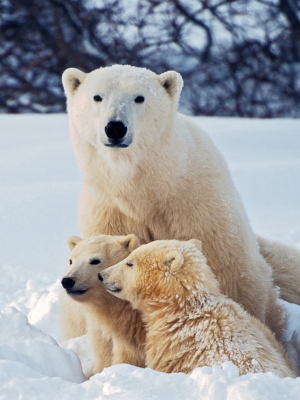As the first week of the new year ends, many of us have made new year’s resolutions that we hope to keep throughout 2025. At Born Free USA, we hope that keeping wild animals where they belong—in the wild—and choosing not to support the use of wild animals in captivity for human entertainment has made it onto your list of resolutions. If you have not yet been convinced that zoos cause more harm to animals than good, we hope that this blog may change your mind as we aspire to move closer to a future free from the exploitation of wild animals from 2025 and on.
The Zoo Industry Peddles Misinformation about Conservation
If you have yet to join the anti-zoo bandwagon, I can understand why. Globally, about 700 million people visited a zoo in 2024. After all, who wouldn’t want to support an industry that claims to help save species threatened with extinction, supposedly offers them happy, simple lives in captivity without experiencing the threats of poaching or habitat loss, or offers front-row views of adorable baby animals? Despite the huge attendance records and their lofty claims about improving wildlife conservation and animal welfare, the zoo industry is responsible for distributing some of the most consistent and widespread misinformation currently available for public consumption.
In fact, most of the animals in a zoo are there simply because they are popular with zoo-goers, not for conservation purposes. Only 23% of land-dwelling vertebrate species found in zoos worldwide are facing extinction. Only 20-25% of threatened or near-threatened mammal species are held in accredited zoos, and only 9% of critically endangered species are kept at zoos. Further, zoo breeding programs don’t even prioritize threatened species; less than half of the mammal and bird species governed by formal breeding programs in North American zoos are threatened in the wild.
Only 23% of land-dwelling vertebrate species found in zoos worldwide are facing extinction. Only 20-25% of threatened or near-threatened mammal species are held in accredited zoos, and only 9% of critically endangered species are kept at zoos.
Zoos Routinely Mistreat Animals for the Benefit of Visitor Entertainment
Regarding animal welfare, a report by World Animal Protection in 2019 flagged hundreds of international zoos affiliated with the World Association of Zoos and Aquariums (WAZA) for mistreating animals. They discovered that 75% of WAZA’s 1,241 member institutions offer at least one animal-visitor interaction, which are inherently stressful for the animals and dangerous to humans due to the risks of injury and disease. The most common activities offered included swimming with dolphins, elephant trunk painting, and shows with big cats. The most common interaction (offered by 43% of the facilities) was petting animals (mostly with mammals or reptiles); about one-third of the facilities offered an experience that involved walking or swimming through an enclosure with animals; and 23% offered hand-feeding experiences.
Zoos Use Creative Marketing to Fool the Public
So—why do zoos have so many people fooled into thinking they exist to save and protect animals? One of the most disturbing findings in recent zoo research is the fact that the zoo industry uses intentionally misleading messaging to justify their exploitation of animals and to convince people of their “advocacy work” for wildlife. For example, a study published in 2024 analyzed the written communication used by three prominent organizations lobbying for zoological parks in Spain. The most representative organization was AIZA (Iberian Society for Zoos and Aquariums), which had a total of 50 member facilities in Portugal and Spain in 2024. AIZA belongs to and follows the guidelines of EAZA (European Association of Zoos and Aquaria) and WAZA (World Association of Zoos and Aquariums), the two largest international trade associations for the zoological industry. The North American equivalent of these organizations is AZA (Association of Zoos and Aquariums).
They found that these organizations use persuasive communication to manipulate public consent into supporting the use of animals in entertainment. This includes promoting concepts of animals held captive in groups as “collections” rather than as individuals, failing to recognize the vast diversities and complexities in behaviors that exist between different animals, comparing nonhuman animals to objects, and encouraging people to consider some species inferior to others. The zoo industry further commodifies nonhuman animals by assigning them a position of labor, be it in breeding programs, genetic value, or as “ambassador animals.”
Zoos Play on the Public’s Compassion for Animals
The study showed that zoo lobby organizations strategically acknowledged the high level of compassion for animals in society and framed themselves as aligned with those values, despite continuing to operate with outdated, exploitative, cruel, and unethical standards of animal care.
While zoos often claim that animals benefit from their work, most zoos have not achieved their supposed goals of improving the population status of animals vulnerable to extinction in the wild or promoting good animal welfare. Even the zoos that partner with in-situ conservation organizations or animal rights groups often only participate in this type of collaboration one time or make it donation-based. The study also explored zoos’ role in “dark tourism,” which typically refers to the act of visiting sites of human death and suffering abroad, but the exhibition of wild animals in captivity, bullfighting, and hunting all provide “dark tourism” experiences as well, as we know that the animals kept at zoos are deprived of the freedom, space, and social opportunities that they would have at their disposal in the wild.
Visiting Zoos = Supporting Animal Exploitation
As the study clearly states: “Focusing on their status as ‘genetic reservoirs’ or species/specimen representatives, the lobbies’ discourse biologizes the complexity of wild nonhuman animals. Reduced to their biological characteristics, their individuality, complexity and emotional lives are erased.”
So, by visiting animals at the zoo (even for the well-meaning, animal-loving person with good, but misinformed intentions), we are inadvertently supporting an industry that does not see animals as individuals, or as beings that deserve the freedom to choose how to live. Zoos see animals as dollar signs that will be born and die in captivity, who have no hope of living the life they evolved to live.
By making one of your new year’s resolutions to stop visiting any facility that exploits wild animals for human entertainment, you can help us get that much closer to saving more animals from this underserving fate in the future.
Keep Wildlife in the Wild,
Devan
Dear Reader,
We are a nonprofit committed to wildlife conservation, welfare, and rescue. Making resources free and widely distributed, like our news items, is an important part of our mission. If you found this article helpful, enjoyable, or enlightening, please donate to help keep these resources available, and Keep Wildlife In The Wild.
Thank You,
The Born Free USA Team

 Dear Reader,
Dear Reader,